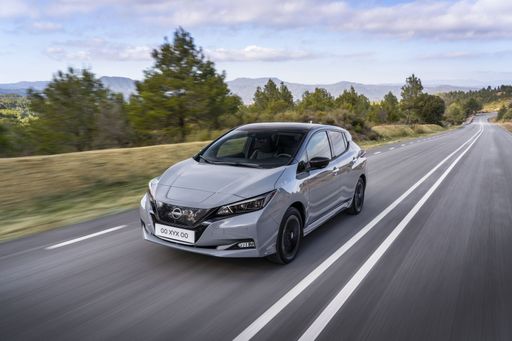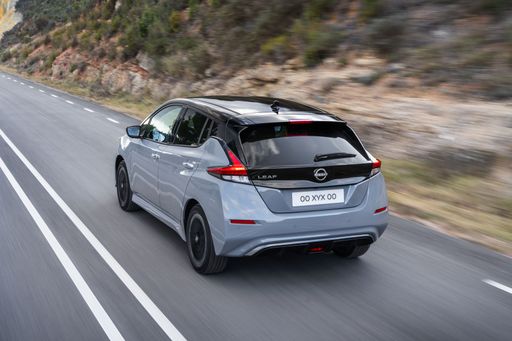Fiat Topolino vs Nissan Leaf – Differences & prices compared
Compare performance, boot space, consumption and price in one view.
Find out now: which car is the better choice for you – Fiat Topolino or Nissan Leaf?
The Fiat Topolino (Hatchback) comes with a Electric engine and Automatic transmission. In comparison, the Nissan Leaf (Hatchback) features a Electric engine with Automatic transmission.
When it comes to boot capacity, the Fiat Topolino offers 63 L, while the Nissan Leaf provides 394 L – depending on how much space you need. If you’re looking for more power, decide whether the 8 HP of the Fiat Topolino or the 217 HP of the Nissan Leaf suits your needs better.
In terms of consumption, the values are per 100 km for the Fiat Topolino, and 16.70 kWh for the Nissan Leaf.
Price-wise, the Fiat Topolino starts at 8500 £, while the Nissan Leaf is available from 30800 £. Compare all the details and find out which model fits your lifestyle best!
Fiat Topolino
The Fiat Topolino is a charming compact vehicle that captures the essence of urban mobility with a distinctive flair. Its retro-inspired design combines seamlessly with modern features, making it a delightful choice for city dwellers seeking style and efficiency. Offering a smooth and nimble driving experience, the Topolino stands out as a testament to Fiat's innovative approach to small car design.
detailsNissan Leaf
The Nissan Leaf stands out as a pioneering model in the realm of electric vehicles, known for its impressive blend of practicality and eco-friendliness. It offers a smooth and quiet driving experience, making it an ideal choice for city commuting and longer journeys alike. The interior design is both comfortable and intuitive, providing drivers with a sense of modernity and ease of use.
details @ germany.nissannews.com
@ germany.nissannews.com
 @ germany.nissannews.com
@ germany.nissannews.com
 @ germany.nissannews.com
@ germany.nissannews.com
 @ germany.nissannews.com
@ germany.nissannews.com

|
|
|
|
|
Costs and Consumption |
|
|---|---|
|
Price
8500 £
|
Price
30800 - 37200 £
|
|
Consumption L/100km
-
|
Consumption L/100km
-
|
|
Consumption kWh/100km
-
|
Consumption kWh/100km
16.7 - 17.8 kWh
|
|
Electric Range
75 km
|
Electric Range
270 - 385 km
|
|
Battery Capacity
5.40 kWh
|
Battery Capacity
39 - 59 kWh
|
|
co2
0 g/km
|
co2
0 g/km
|
|
Fuel tank capacity
-
|
Fuel tank capacity
-
|
Dimensions and Body |
|
|---|---|
|
Body Type
Hatchback
|
Body Type
Hatchback
|
|
Seats
2
|
Seats
5
|
|
Doors
2 - 3
|
Doors
5
|
|
Curb weight
562 kg
|
Curb weight
1580 - 1756 kg
|
|
Trunk capacity
63 L
|
Trunk capacity
385 - 394 L
|
|
Length
2535 mm
|
Length
4490 mm
|
|
Width
1400 mm
|
Width
1788 mm
|
|
Height
1530 mm
|
Height
1540 - 1545 mm
|
|
Payload
138 kg
|
Payload
384 - 415 kg
|
Engine and Performance |
|
|---|---|
|
Engine Type
Electric
|
Engine Type
Electric
|
|
Transmission
Automatic
|
Transmission
Automatic
|
|
Transmission Detail
Reduction Gearbox
|
Transmission Detail
Reduction Gearbox
|
|
Drive Type
Front-Wheel Drive
|
Drive Type
Front-Wheel Drive
|
|
Power HP
8 HP
|
Power HP
150 - 217 HP
|
|
Acceleration 0-100km/h
-
|
Acceleration 0-100km/h
6.9 - 7.9 s
|
|
Max Speed
45 km/h
|
Max Speed
144 - 157 km/h
|
|
Torque
44 Nm
|
Torque
320 - 340 Nm
|
|
Number of Cylinders
-
|
Number of Cylinders
-
|
|
Power kW
6 kW
|
Power kW
110 - 160 kW
|
|
Engine capacity
-
|
Engine capacity
-
|
General |
|
|---|---|
|
Model Year
2023
|
Model Year
2019
|
|
CO2 Efficiency Class
A
|
CO2 Efficiency Class
A
|
|
Brand
Fiat
|
Brand
Nissan
|
Fiat Topolino
Exploring the Fiat Topolino: A Modern Urban Companion
The Fiat Topolino, a name that evokes nostalgia and charm, is making waves in the automotive world once again. With its compact dimensions and eco-friendly electric engine, it aims to redefine urban mobility. But what sets this vehicle apart? Let's delve into the technical details and innovations that make the Fiat Topolino a standout choice.
A Retro-Inspired Design with Modern Sensibilities
Fiat has carefully crafted the Topolino to exude a vintage appeal while incorporating the necessities of modern driving. Its compact body—a mere 2535 mm in length—makes it perfect for navigating tight city streets. Despite its small stature, the car offers ample headroom and a surprising level of comfort with its dimensions measuring 1400 mm in width and 1530 mm in height.
Electric Mobility for the Urban Explorer
Under the bonnet, the Fiat Topolino features an electric motor that generates a modest yet efficient 8 PS (6 kW). Harnessing power from a 5.4 kWh lithium-ion battery, the Topolino offers a commendable range of 75 km, ideal for short city commutes. The automatic transmission paired with the front-wheel-drive configuration ensures a smooth and effortless driving experience.
Performance and Efficiency Reimagined
Although the Topolino's maximum speed peaks at 45 km/h, it's designed with urban agility in mind rather than speed. The 44 Nm of torque provides adequate power for acceleration in city traffic, ensuring that drivers can navigate urban landscapes with ease.
Inside the Cabin: Comfort and Practicality
Despite its compact size, the Fiat Topolino does not compromise on comfort. It accommodates two seats, making it an excellent choice for solo travellers or couples looking for an eco-friendly car. The car's minimalist style extends to its cargo space, offering a practical boot with a capacity of 63 litres.
Innovative and Eco-Friendly Credentials
One of the most significant innovations of the Fiat Topolino is its commitment to eco-friendliness. With zero tailpipe emissions, the car is assigned an 'A' CO2 efficiency class, making it a top choice for environmentally conscious drivers. Additionally, its lightweight design, with a kerb weight of just 562 kg, ensures that the vehicle retains agility, which is perfect for city driving.
Conclusion: The Ideal Urban Solution
The Fiat Topolino stands as a testament to Fiat's ability to blend the charm of the past with the demands of the present. Its retro design, compact build, and sustainable technology make it an ideal urban transportation solution. While it may not be everyone's cup of tea for long journeys, it excels in the role it was crafted for: an efficient, eco-friendly city car.
Nissan Leaf
Introduction to the Nissan Leaf: A Pioneer in Electric Mobility
The Nissan Leaf has established itself as a trailblazer in the realm of electric vehicles (EVs) since its launch. As we delve into its present-day iterations, the Leaf continues to soar in popularity due to remarkable advancements in technology and sustainability. Let's explore what makes the Nissan Leaf a standout in today's automotive market.
Power and Performance: Under the Hood of the Nissan Leaf
The Nissan Leaf boasts a power output ranging from 150 to 217 PS, depending on the battery option chosen. The vehicle's electric motor, a product of cutting-edge engineering, offers instant torque ranging from 320 to 340 Nm, resulting in impressive acceleration capabilities. The 0 to 100 km/h dash is achieved in as little as 6.9 seconds, showcasing its prowess in electric performance.
Battery Technology: Efficient Energy Management
When discussing the Nissan Leaf, battery technology is at the forefront. The available battery capacities range from 39 to 59 kWh, supporting an electric range between 270 to 385 km. This flexibility allows drivers to choose a model that best fits their driving habits, providing peace of mind for longer journeys without frequent recharging.
Sustainability: The Environmental Edge
One of the primary attractions of the Nissan Leaf is its commitment to sustainability. As an all-electric vehicle, it produces zero CO2 emissions, placing it in the top tier of the CO2-efficiency class with an 'A' rating. This clean energy approach contributes significantly to reducing environmental impact and supports Nissan's drive towards a greener future.
Design and Comfort: Aesthetic Appeal and Practicality
The Nissan Leaf is not just about efficiency; it's also designed for comfort and utility. With its sleek hatchback body and dimensions of 4490 mm in length, 1788 mm in width, and a height of up to 1545 mm, it offers ample interior space. The boot capacity ranges from 385 to 394 litres, providing sufficient storage for everyday needs. The model accommodates five passengers comfortably, ensuring a pleasant ride for everyone.
Innovations and Safety: Advanced Features for Peace of Mind
Nissan equips the Leaf with an array of intelligent features that enhance safety and convenience. The available equipment lines, including N-CONNECTA, Tekna, e+ N-CONNECTA, and e+ Tekna, offer varying levels of technology integration. ProPILOT Assist, e-Pedal, and a comprehensive suite of driver-assistance technology are just a few examples that highlight Nissan's commitment to innovation in the EV market.
Conclusion: The Nissan Leaf Continues to Lead
With prices ranging from €35,900 to €43,400, the Nissan Leaf remains an attractive choice for those looking to embrace electric mobility. It perfectly balances performance, design, and sustainability, making it a compelling choice in the competitive EV landscape. The Nissan Leaf not only represents the future of driving but also reinforces why it continues to be a leader in the electric vehicle community.
What drive types are available for the Fiat Topolino?
The Fiat Topolino is available as Front-Wheel Drive.
The prices and data displayed are estimates based on German list prices and may vary by country. This information is not legally binding.
